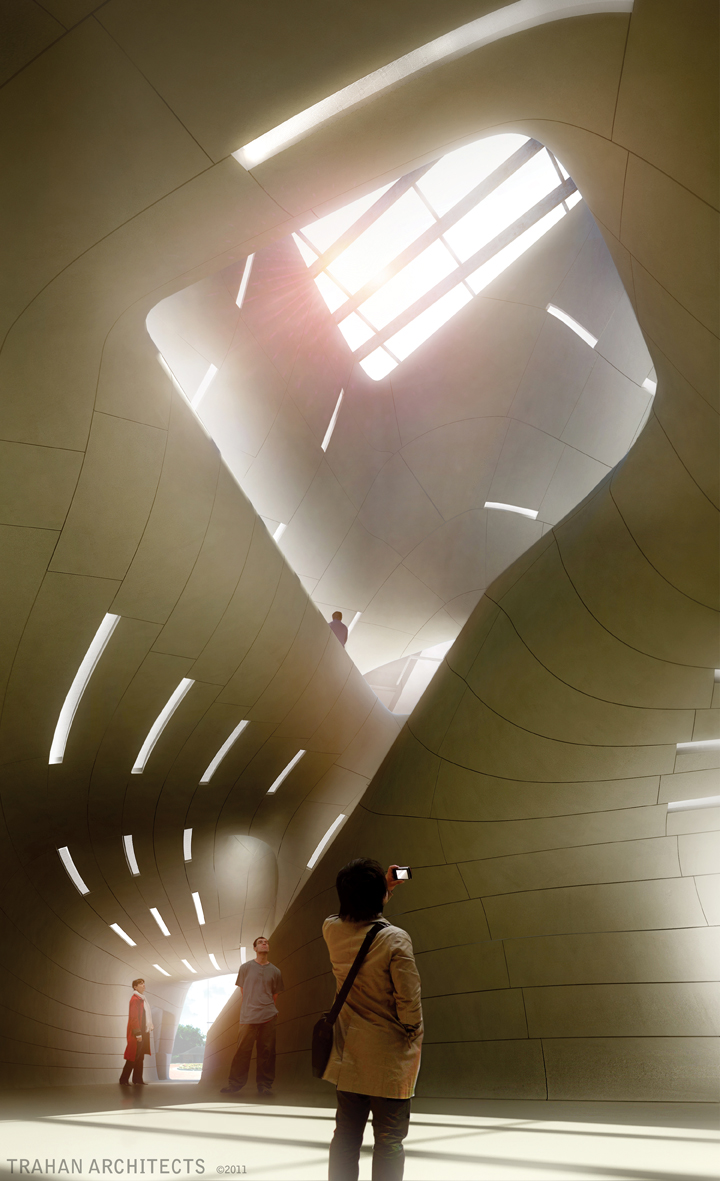The Louisiana State Sports Hall of Fame is currently being built in Natchitoches, one of the Old West settlements in the Louisiana Purchase. The $12 million, 22,000-sf project will celebrate memorabilia donated by 250 Cajun country sports heroes and showcase their impact on the state. Trahan Architects of Baton Rouge designed a contemporary, curvilinear building to express not just local materials, but the land of northern Louisiana, too.
When it’s completed next March, the building will be in the form of a curvilinear museum substructure situated in a box of native cypress-timber planks. According to Victor “Trey” Trahan, FAIA, president and principal-in-charge of Trahan Architects, the design of the building itself is meant to recall both the hilly topography of northern Louisiana and the flow of the Cane River, while the exterior box controls light and shadow outside the building. Fluid shapes of river channels are separated by interstitial masses in the curvilinear structure, the same way that delta islands separate the waters of a river, thus creating the organizing principle for visitor circulation and gallery arrangement in the museum.
However, that expressive design required coordination and planning that just wouldn’t be possible without the use of 3D BIM. While this was a traditional design-bid-build project, the owner, the state of Louisiana, and the design architect both wanted a BIM consultant to oversee the creation of the precast concrete panels on the substructure inside the outer box. Trahan also required that five-axis CNC milling be used for the formwork of the exterior panels. Case Building + Technology, a BIM and integrated practice consultancy based in New York, was originally brought into the Building Team by the architect, but eventually became a design consultant and BIM manager for the construction manager, VCC of Little Rock, Ark. Case was founded in 2008 by several former members of SHoP Architects, a firm that delivered some very intricate BIM projects, including the 290 Mulberry Street Condominiums (http://www.290mulberry.com) in New York.
“There needed to be expertise at the level of panel fabrication that typically is just not available to the design architect that early in the process,” said Federico Negro, the partner-in-charge on the project for Case Building + Technology.
Trahan Architects used Rhino 3D (.3dm file format), a NURBS tool, for the free-form, curvilinear exterior skin model of the substructure. Trahan originated that model in Autodesk Maya, a 3D animation software used mainly by the film and gaming industries, and brought it into Rhino to add geometric information. They also provided an Autodesk Revit (.rvt) model of the entire project. Still, without actual field conditions built into the model, the precast concrete panels themselves couldn’t be molded and created with any level of detail necessary for installation. Case analyzed the entire skin model and determined that a total of 1,030 separate precast panels would be needed with 4-8 connections to the underlying steel frame for each panel. The whole surface was analyzed for gaps and constructability questions, and all gaps had to be fixed on the model’s surface. Each pair of connecting panels had to achieve a tolerance of a quarter-inch between them.
They also had to coordinate connections with the model of structural engineer, LBYD of Birmingham, Ala. The support steel had to be analyzed for clash detection with the concrete panels. Two clash detection programs were used on the project: Gehry Technologies’ Digital Project and Autodesk Navisworks Manage. All panel-to-panel clearance detection was done in Digital Project. For trade coordination, which fell under Case’s purview as the overall BIM manager for VCC, Navisworks was used because of its robust import/export capabilities and the sheer numbers of different software packages (14 different programs) the trade subcontractors were using on the project.
“That’s just the way we like to work,” said Case Building + Technology’s Negro. “We’re not going to specify something else for a fabricator or anyone else to learn and use on a project. We want to be as far from top-down as possible. Working directly for the CM and down through all trades gave us a much bigger perspective of the overall project and really integrated everyone on the team.”
Once the design skin model was rationalized, made seamless, and quality-checked for constructability, an automated program then sent a unique shop ticket for each panel to fabricator Advanced Cast Stone of Fort Worth, Texas. The shop tickets were created in Rhino via Rhinoscript. The script took a computer folder of panel file information and automatically created a shop ticket for each panel. The program automatically placed the embed points on the panel, prepared a fabrication file for molds, and created all the cameras and views needed for the visual part of the ticket itself. The script also created a table articulating and explaining all the different embed types on that panel. That information went into the shop ticket and an accompanying .csv file capable of being opened in Microsoft Excel. This automated process created a simple set of points to tell the shop what was needed to create each of the 1,030 panels delivered in a STEP (.step). Four corners and connection points were named and articulated in each shop ticket, and a shop drawing accompanied each ticket.
To track coordination problems between structural, MEP, and fire protection, Case used Web-based tracking tool Jira (https://www.atlassian.com/software/jira), developed by Australian software company Atlassian, which is primarily used for tracking bugs in computer code. However, it worked just as well for tracking clashes as it does for finding bugs.
All the precast concrete panels have now been fabricated, and installation began in early August in Natchitoches. The project is on track to open in March.
“Protecting design intent is always a big factor here,” Negro said. “Having people that can demystify surfaces and geometry is a big part of what we do, and it is hard work on such a complex design, but it’s not impossible to preserve that design. Not even close.” BD+C
Related Stories
Designers | Oct 1, 2024
Global entertainment design firm WATG acquires SOSH Architects
Entertainment design firm WATG has acquired SOSH Architects, an interior design and planning firm based in Atlantic City, N.J.
Higher Education | Sep 30, 2024
Studio Gang turns tobacco warehouse into the new home of the University of Kentucky’s College of Design
Studio Gang has completed the Gray Design Building, the new home of the University of Kentucky’s College of Design. In partnership with K. Norman Berry Associates Architects, Studio Gang has turned a former tobacco warehouse into a contemporary facility for interdisciplinary learning and collaboration.
Warehouses | Sep 27, 2024
California bill would limit where distribution centers can be built
A bill that passed the California legislature would limit where distribution centers can be located and impose other rules aimed at reducing air pollution and traffic. Assembly Bill 98 would tighten building standards for new warehouses and ban heavy diesel truck traffic next to sensitive sites including homes, schools, parks and nursing homes.
Laboratories | Sep 27, 2024
Traditional lab design doesn't address neurodiverse needs, study finds
A study conducted by ARC, HOK, and the University of the West of Scotland, has revealed that half (48.1%) of all survey respondents who work in laboratory settings identify as neurodivergent.
Laboratories | Sep 26, 2024
BSL conversions: A cost-efficient method to support high-containment research
Some institutions are creating flexible lab spaces that can operate at a BSL-2 and modulate up to a BSL-3 when the need arises. Here are key aspects to consider when accommodating a rapid modulation between BSL-2 and BSL-3 space.
MFPRO+ News | Sep 24, 2024
Major Massachusetts housing law aims to build or save 65,000 multifamily and single-family homes
Massachusetts Gov. Maura Healey recently signed far-reaching legislation to boost housing production and address the high cost of housing in the Bay State. The Affordable Homes Act aims to build or save 65,000 homes through $5.1 billion in spending and 49 policy initiatives.
Designers | Sep 20, 2024
The growing moral responsibility of designing for shade
Elliot Glassman, AIA, NCARB, LEED AP BD+C, CPHD, Building Performance Leader, CannonDesign, makes the argument for architects to consider better shade solutions through these four strategies.
Mixed-Use | Sep 19, 2024
A Toronto development will transform a 32-acre shopping center site into a mixed-use urban neighborhood
Toronto developers Mattamy Homes and QuadReal Property Group have launched The Clove, the first phase in the Cloverdale, a $6 billion multi-tower development. The project will transform Cloverdale Mall, a 32-acre shopping center in Toronto, into a mixed-use urban neighborhood.
Codes and Standards | Sep 19, 2024
Navigating the intricacies of code compliance and authorities having jurisdiction
The construction of a building entails navigating through a maze of regulations, permits, and codes. Architects are more than mere designers; we are stewards of safety and navigators of code compliance.
Higher Education | Sep 18, 2024
Modernizing dental schools: The intersection of design and education
Page's John Smith and Jennifer Amster share the how firm's approach to dental education facilities builds on the success of evidence-based design techniques pioneered in the healthcare built environment.

















